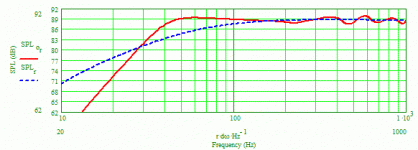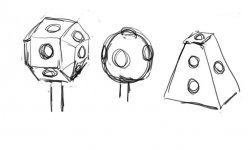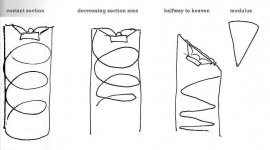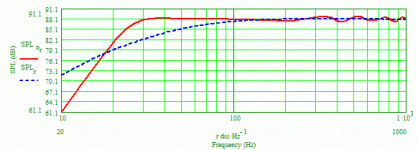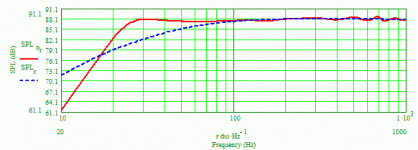In a smaller-volume line..
Staying with the L22RNX/P, I reduced the line's volume by changing the starting area to 2 Sd and ending area to 0.2Sd, resulting in the system response as shown in the attached graph. The line's resonant frequency is still 28 Hz, but with a smaller included volume, F3 is higher as can be seen.
Staying with the L22RNX/P, I reduced the line's volume by changing the starting area to 2 Sd and ending area to 0.2Sd, resulting in the system response as shown in the attached graph. The line's resonant frequency is still 28 Hz, but with a smaller included volume, F3 is higher as can be seen.
Attachments
tweeter head and on and on and on ...
Sorry for hijacking the thread with my fixations , but apparently this is the right one.
I know you guys are already messing with the tons of fiberglass you bought and also begging the workers on the road to fill two jars of tar for a project of your own...
So the elected tweeter would be the TB ceramic one , 4 ohm , by throwing 8 of this in each TH ( tweeter head ...) ,two by two in parallel then serialized obtaining 8 ohm.This tweeter goes down to 800 Hz and rises to 30 Khz ,so the original design of Sergio-f of a 3 way implementation would be eased.
Scrolling down on Pxpress the size and the cost of the drivers , I've reached the Dayton ND16FA-6 . 6 of these in the TH makes 9 ohm . I would go to low power ones like these . For being complete why not mention the Hivi X1 , 4 ohm , and the Tymphany RD0689 , which is a nice little oval 1'' dome tweeter also with a nice curve shaped flange and oly two holes for the mount.
So there are plenty of choices of products available , an we need plenty of tweeters ,
the quasi spherical box allows to place them everywhere , firing in all directions (Cad designers and speakers simulators needed ! ! !) ,the size can be reduced or enlarged depending on the number of drivers , and also power handling can be managed easily by connecting low power units together.
Sorry for hijacking the thread with my fixations , but apparently this is the right one.
I know you guys are already messing with the tons of fiberglass you bought and also begging the workers on the road to fill two jars of tar for a project of your own...
So the elected tweeter would be the TB ceramic one , 4 ohm , by throwing 8 of this in each TH ( tweeter head ...) ,two by two in parallel then serialized obtaining 8 ohm.This tweeter goes down to 800 Hz and rises to 30 Khz ,so the original design of Sergio-f of a 3 way implementation would be eased.
Scrolling down on Pxpress the size and the cost of the drivers , I've reached the Dayton ND16FA-6 . 6 of these in the TH makes 9 ohm . I would go to low power ones like these . For being complete why not mention the Hivi X1 , 4 ohm , and the Tymphany RD0689 , which is a nice little oval 1'' dome tweeter also with a nice curve shaped flange and oly two holes for the mount.
So there are plenty of choices of products available , an we need plenty of tweeters ,
the quasi spherical box allows to place them everywhere , firing in all directions (Cad designers and speakers simulators needed ! ! !) ,the size can be reduced or enlarged depending on the number of drivers , and also power handling can be managed easily by connecting low power units together.
Ok forget the TH
It was a resemblance coming from the past (They don't ..die!),just dropped here.
Forget it ! I'll do the filthy job...
To Sergiof - The first time I looked at your sketch I thought :"What a waste of space!"
It made me thinking of a japanese I saw somewhere in the web space that built transmission lines with an helix inside a large PVC , with constant measure throughout the line . Also that reminded me of commercials seen on tv of vegetable cutters like zucchini , pickles and so on ,where the blade makes a circle to its fulcrum which is a needle pointed in the center of the poor vegetable.
We should ask OGM manufacturers to produce big pickles to be cut that way and when dried to be solid . Otherwise , cut a lot of sectors and glue them together and around the pole , but it seems like putting a ship inside a bottle ... for a profane !
So..confusion..chaos...B&W nautilus appearing and vanishing...big plastic molders that melts in the kitchen...inches that become feet when the wrong law is applied...so?
Let's get back to my assertion , better trust to your own intuitions .
Just leaving the snake look , this speaker can be made by using a 15'' PVC tube , the gray or cyan ones which are very "fat" , and double tall.
Just drop there the peeled zucchini with lots of hot glue , put back in the oven ..et voilà. La maison de l'audiophile c'est ici.
It was a resemblance coming from the past (They don't ..die!),just dropped here.
Forget it ! I'll do the filthy job...
To Sergiof - The first time I looked at your sketch I thought :"What a waste of space!"
It made me thinking of a japanese I saw somewhere in the web space that built transmission lines with an helix inside a large PVC , with constant measure throughout the line . Also that reminded me of commercials seen on tv of vegetable cutters like zucchini , pickles and so on ,where the blade makes a circle to its fulcrum which is a needle pointed in the center of the poor vegetable.
We should ask OGM manufacturers to produce big pickles to be cut that way and when dried to be solid . Otherwise , cut a lot of sectors and glue them together and around the pole , but it seems like putting a ship inside a bottle ... for a profane !
So..confusion..chaos...B&W nautilus appearing and vanishing...big plastic molders that melts in the kitchen...inches that become feet when the wrong law is applied...so?
Let's get back to my assertion , better trust to your own intuitions .
Just leaving the snake look , this speaker can be made by using a 15'' PVC tube , the gray or cyan ones which are very "fat" , and double tall.
Just drop there the peeled zucchini with lots of hot glue , put back in the oven ..et voilà. La maison de l'audiophile c'est ici.
i'm sorry for the delay in the reply, but I had no real access to the internet for a bit of time.
pkitt: thank you so much for your teachings and experiments! thanks to them i can take some interesting conclusions... one of them is the influence of tappering (i must confess that fist i was scared since instead of reading 10:1, i read 10Sd, eheheheheheh). the other one is the undesired response of this woofer.
you see, i was trying to create a speaker that would enable me to reproduce 20Hz-20KHz without big restraints. that's why i chose 3 ways, and the 21Hz Fs of the Seas L22RNX4P (by the way my current 2way loudspeaker does -3dB at 26Hz). this said, do you have any suggestion? would the L26 woofer do that? do you know any other? (i'd rather it to be metalic).
still, don't think your work went all to the trash, quite the contrary! i'm really thankful for what you made me learn!
picowallspeaker, you're way to farfetched
but please explain to me better the PVC model (I must confess I used PVC one and ended up way not pleased with the results). how do you tapper it?
pkitt: thank you so much for your teachings and experiments! thanks to them i can take some interesting conclusions... one of them is the influence of tappering (i must confess that fist i was scared since instead of reading 10:1, i read 10Sd, eheheheheheh). the other one is the undesired response of this woofer.
you see, i was trying to create a speaker that would enable me to reproduce 20Hz-20KHz without big restraints. that's why i chose 3 ways, and the 21Hz Fs of the Seas L22RNX4P (by the way my current 2way loudspeaker does -3dB at 26Hz). this said, do you have any suggestion? would the L26 woofer do that? do you know any other? (i'd rather it to be metalic).
still, don't think your work went all to the trash, quite the contrary! i'm really thankful for what you made me learn!
picowallspeaker, you're way to farfetched
but please explain to me better the PVC model (I must confess I used PVC one and ended up way not pleased with the results). how do you tapper it?
Hello.
Though I don't know still what a "tap" is ,me so horny!,I learned something too.
brutally :To stick a spiral in a PVC pipe shouldn't be difficult , it takes patience and time by using a single piece of 1 cm mdf repeated all along the "line",just a sector of a circle the less and less inclined till the throat.
Though I don't know still what a "tap" is ,me so horny!,I learned something too.
brutally :To stick a spiral in a PVC pipe shouldn't be difficult , it takes patience and time by using a single piece of 1 cm mdf repeated all along the "line",just a sector of a circle the less and less inclined till the throat.
Attachments
tappering? meaning the sectional area of the pipe gets smaller as it distances from the driver... but i like your ideas!
this is offtopic pkitt, but maybe you could do me a favor (if you don't mind, obviously). a relative of mine is building John Eekel's Scoperta's, but he would like to build them smaller. the woofer used is the W15LY, and the pipe lengh is about 150cm (tapper: 2Sd-0,5Sd, so 4:1).
is it possible to apply your 10:1 "rule" (3Sd-0,3Sd)? how long would the pipe be?
thank you in advance!
this is offtopic pkitt, but maybe you could do me a favor (if you don't mind, obviously). a relative of mine is building John Eekel's Scoperta's, but he would like to build them smaller. the woofer used is the W15LY, and the pipe lengh is about 150cm (tapper: 2Sd-0,5Sd, so 4:1).
is it possible to apply your 10:1 "rule" (3Sd-0,3Sd)? how long would the pipe be?
thank you in advance!
Converting a 4:1 tapered line that's 150 cm long to an equivalent 10:1 tapered line would result in a line thats ~123 cm long, not a really big change, and to maintain the same F3, the 10:1 tapered line would have to have the same internal volume as the 4:1 tapered line. The 10:1 taper should, however, show a significant improvement in overall smoothness above 200 Hz or so. There's nothing magical about using a 3Sd to 0.3 Sd taper; it may or may not be optimum for a given driver.
sergiof said:tappering? meaning the sectional area of the pipe gets smaller as it distances from the driver... but i like your ideas!
this is offtopic pkitt, but maybe you could do me a favor (if you don't mind, obviously). a relative of mine is building John Eekel's Scoperta's, but he would like to build them smaller. the woofer used is the W15LY, and the pipe lengh is about 150cm (tapper: 2Sd-0,5Sd, so 4:1).
is it possible to apply your 10:1 "rule" (3Sd-0,3Sd)? how long would the pipe be?
thank you in advance!
When designing a TL, whatever its type, for a specific driver there will be an optimum system tuning frequency, meaning IMO an overall smooth and flat response down to the knee in the curve above F3. In a tapered line, or a non-tapered traditional line, the line's quarter wavelength resonant frequency is adjusted up or down to attain this characteristic. Then, the desired F3 is obtained by adjusting the volume within the line, assuming the driver is capable, of course. Basically, the bigger the box, the lower F3 can be. So, if you're willing to make the box bigger, it might be possible to get your desired F3 with either of the L22 drivers (but it might not). I can certainly model some TLs for the L26RFX/P for you. Do you have any box size and/or shape constraints?
sergiof said:i'm sorry for the delay in the reply, but I had no real access to the internet for a bit of time.
pkitt: thank you so much for your teachings and experiments! thanks to them i can take some interesting conclusions... one of them is the influence of tappering (i must confess that fist i was scared since instead of reading 10:1, i read 10Sd, eheheheheheh). the other one is the undesired response of this woofer.
you see, i was trying to create a speaker that would enable me to reproduce 20Hz-20KHz without big restraints. that's why i chose 3 ways, and the 21Hz Fs of the Seas L22RNX4P (by the way my current 2way loudspeaker does -3dB at 26Hz). this said, do you have any suggestion? would the L26 woofer do that? do you know any other? (i'd rather it to be metalic).
still, don't think your work went all to the trash, quite the contrary! i'm really thankful for what you made me learn!
picowallspeaker, you're way to farfetched
but please explain to me better the PVC model (I must confess I used PVC one and ended up way not pleased with the results). how do you tapper it?
about you first reply, thank you greatly! i'm going to warn my friend (i also found an article about an 1/8 wave TL that may be interesting).
about "my" loudspeaker, i have no size restraint, and i'd like to make it tubular (although i'd prefer to avoid the Nautilus design, for originality reasons), but not even that is an absolute need.
let me just say that if people were all like you (or like picowallspeaker) the world would be a better place, for sure! i'm really enjoying your help, and learning from you both! thank you!
about "my" loudspeaker, i have no size restraint, and i'd like to make it tubular (although i'd prefer to avoid the Nautilus design, for originality reasons), but not even that is an absolute need.
let me just say that if people were all like you (or like picowallspeaker) the world would be a better place, for sure! i'm really enjoying your help, and learning from you both! thank you!
Tapered TL for L26RFX/P
Using Seas published specs for this driver I found on Madisound's site, I modeled a ~15:1 tapered TL. The line is 72" long, begins at the driver end (the closed end) with an area of 3.82 Sd, and ends at the terminus end (the open end) with an area of 0.25 Sd. The woofer's center would be located 14" from the beginning of the line. I used a stuffing density of 1 lb/cu.ft., requiring ~50 ounces of stuffing uniformly distributed by density in the first 37" of the line's length. I arbitrarily modeled assuming there would be 0.5 ohms in series with the woofer. The system tuning frequency, essentially this line's quarter wavelenght resonant frequency, turned out to be optimum for this woofer in the 21-22 Hz range. I've attached a graph of the system response, representing its output with a 2.83-volt input. As you can see, F3 is about 24-25 Hz; it could be made even lower if the line's volume was increased.
Using Seas published specs for this driver I found on Madisound's site, I modeled a ~15:1 tapered TL. The line is 72" long, begins at the driver end (the closed end) with an area of 3.82 Sd, and ends at the terminus end (the open end) with an area of 0.25 Sd. The woofer's center would be located 14" from the beginning of the line. I used a stuffing density of 1 lb/cu.ft., requiring ~50 ounces of stuffing uniformly distributed by density in the first 37" of the line's length. I arbitrarily modeled assuming there would be 0.5 ohms in series with the woofer. The system tuning frequency, essentially this line's quarter wavelenght resonant frequency, turned out to be optimum for this woofer in the 21-22 Hz range. I've attached a graph of the system response, representing its output with a 2.83-volt input. As you can see, F3 is about 24-25 Hz; it could be made even lower if the line's volume was increased.
sergiof said:about you first reply, thank you greatly! i'm going to warn my friend (i also found an article about an 1/8 wave TL that may be interesting).
about "my" loudspeaker, i have no size restraint, and i'd like to make it tubular (although i'd prefer to avoid the Nautilus design, for originality reasons), but not even that is an absolute need.
let me just say that if people were all like you (or like picowallspeaker) the world would be a better place, for sure! i'm really enjoying your help, and learning from you both! thank you!
Attachments
For kicks, an ML-TL for the L26
I modeled an ML-TL that's also 72" long, with the driver located 14" from the beginning of the line. This line has a constant cross-sectional area (not tapered) of 2 Sd, and instead of there being a terminus at the end of the line, there is a mass-loading port, with a diameter of 3.5" and a length of 7.5". The stuffing density is also 1 lb/cu.ft. but you'd need only 36 ounces of stuffing in the first 37" of the line. I've attached the system response graph, on which you can see that F3 is a bit lower (~ 22 Hz). This line and the previous tapered line have virtually identical internal volumes. You can compare this graph to the previous graph to understand the pros and cons of each type of line. Of course the best thing about an ML-TL is that it's a lot easier to build since it's not tapered, and the second best thing is it will always have a lower F3 than an equivalent tapered line having the same volume.
I modeled an ML-TL that's also 72" long, with the driver located 14" from the beginning of the line. This line has a constant cross-sectional area (not tapered) of 2 Sd, and instead of there being a terminus at the end of the line, there is a mass-loading port, with a diameter of 3.5" and a length of 7.5". The stuffing density is also 1 lb/cu.ft. but you'd need only 36 ounces of stuffing in the first 37" of the line. I've attached the system response graph, on which you can see that F3 is a bit lower (~ 22 Hz). This line and the previous tapered line have virtually identical internal volumes. You can compare this graph to the previous graph to understand the pros and cons of each type of line. Of course the best thing about an ML-TL is that it's a lot easier to build since it's not tapered, and the second best thing is it will always have a lower F3 than an equivalent tapered line having the same volume.
Attachments
thank you!
both of them go around 20Hz at -6dB, as desired, which is great.
ok, as soon as i have time, i'll prepare a project and i'll put it up in here.
meanwhile, maybe you can help me about the midwoofer box. my idea was for it to be a mix between the Sound E-motion and the nOhr speakers. do you have any sugestions?
both of them go around 20Hz at -6dB, as desired, which is great.
ok, as soon as i have time, i'll prepare a project and i'll put it up in here.
meanwhile, maybe you can help me about the midwoofer box. my idea was for it to be a mix between the Sound E-motion and the nOhr speakers. do you have any sugestions?
Sorry, Sergiof, I can't help you on your two listed midwoofer selections because I really don't know anything about them.
sergiof said:thank you!
both of them go around 20Hz at -6dB, as desired, which is great.
ok, as soon as i have time, i'll prepare a project and i'll put it up in here.
meanwhile, maybe you can help me about the midwoofer box. my idea was for it to be a mix between the Sound E-motion and the nOhr speakers. do you have any sugestions?
eheheheh
don't feel sorry! you helped me a lot!
well, these are the nOhr:
my curiosity on this box is if it is a tipical bass reflex enclosure or something else.
and these are the sound e-motion:
a mix of them both would look something very similar to what you can find in the B&W 802D midwoofer box.
i once built something similar, but as being a bass reflex enclosure for a very very tiny "airplane carriable" mini-monitor (using the tangband W3-851):
still don't know if i should repeat the design.
don't feel sorry! you helped me a lot!
well, these are the nOhr:
An externally hosted image should be here but it was not working when we last tested it.
my curiosity on this box is if it is a tipical bass reflex enclosure or something else.
and these are the sound e-motion:
An externally hosted image should be here but it was not working when we last tested it.
a mix of them both would look something very similar to what you can find in the B&W 802D midwoofer box.
i once built something similar, but as being a bass reflex enclosure for a very very tiny "airplane carriable" mini-monitor (using the tangband W3-851):
An externally hosted image should be here but it was not working when we last tested it.
still don't know if i should repeat the design.
Forget it , Sergiostill don't know if i should repeat the design
Pkitt has given solid basis of truth.That's something that you -me- can count on.
For midrange and tweeter mounting , we must consider vertical alignement of the sound sources , or at least listener's position respect to the speakers.
I really don't know....The snake TL appeals me , the Nohr and the sound E-motion are good handcrafts , but for me a speaker cabinet has to be authoritative , where a bouncing wave doesn't want to bounce anymore because it scares !
Just have taken a look to the B&W , they confute my statement.
Just returned from museum of archeology where a percussionist filled the room with pure sound just touching big bowls .Amazing . I just wished I could reproduce those tones electroacoustically .<But also the slam of a drum , bass ,guitar alltogether>
I suspect the snake made of fiberglass is in need of a mechanical structure ,could be the bar in the middle ,or some points where to discharge some energy .
why not 2 way ,sergio , fffkrkl ghhh eh?
picowallspeaker,
maybe i explained it badly.
the idea is to have the "snaky" bassbox reproducing all the frequencies, lets say, below 100-300Hz (still to be determined), using a electronic x-over.
the mids and highs will be reproduced by an independent box (containing a small midwoofer and a tweeter), for which the nOrh/sound e-motion/B&W Nautilus midwoofer/my tiny speakers (picostandspeakers, eheheheh) kind of box is being thought. i also want them to be able to play independently, and therefore i need a "bass system".
so the discussion is not if i should go 2 or 3 way, but rather going 2 AND 3 way . in a 3 way system, the midwoofer box will receive frequencies above the porting system working area, so it won't be listenable. if i switch the xover down (and do not turn the bassbox amp on) i'll be able to listen just to the bookshelf speaker.
. in a 3 way system, the midwoofer box will receive frequencies above the porting system working area, so it won't be listenable. if i switch the xover down (and do not turn the bassbox amp on) i'll be able to listen just to the bookshelf speaker.
maybe i explained it badly.
the idea is to have the "snaky" bassbox reproducing all the frequencies, lets say, below 100-300Hz (still to be determined), using a electronic x-over.
the mids and highs will be reproduced by an independent box (containing a small midwoofer and a tweeter), for which the nOrh/sound e-motion/B&W Nautilus midwoofer/my tiny speakers (picostandspeakers, eheheheh) kind of box is being thought. i also want them to be able to play independently, and therefore i need a "bass system".
so the discussion is not if i should go 2 or 3 way, but rather going 2 AND 3 way
That's good . Night and day .
Just a "click" and no more bass .
Probably you'll regret the lack of the lower octaves when switching to the "night system " . Why not going towards a sensitive system also capable to produce a "slam" thunderous sound ?
I'm too brainy , maybe I should find the time to experiment with fiberglass construction , even if I think PVC pipes are useful ready made material.
Now I'm going away for the weekend , I'll fill my sketchbook with absurd designs and on Monday I hope to share some thoughts and ideas .I wish that it will be useful for everybody to share ideas and not turn to a dead end .
PS. sergio , don't you need just a subwoofer ????
Just a "click" and no more bass .
Probably you'll regret the lack of the lower octaves when switching to the "night system " . Why not going towards a sensitive system also capable to produce a "slam" thunderous sound ?
I'm too brainy , maybe I should find the time to experiment with fiberglass construction , even if I think PVC pipes are useful ready made material.
Now I'm going away for the weekend , I'll fill my sketchbook with absurd designs and on Monday I hope to share some thoughts and ideas .I wish that it will be useful for everybody to share ideas and not turn to a dead end .
PS. sergio , don't you need just a subwoofer ????

pkitt:
i just designed a model according to your measurements, and two things ýmmediately shown up:
1 - the best shape for it resemples slightly a pipe, seen with the burning cavity facing backwards and the mouth piece facing upwards. the woofer would be on the "knee" (later i'll put this idea attached).
2- it's interesting as drawing this gave me the idea that if the pipe was bigger, it would be easier to build. do you mind simulating a bigger volume for a tappered pipe, please? if, for example, you can reach the 20Hz at -3dB that would be doubly perfect: bigger size and the desired 20Hz.
picowallspeaker:
i'm just imagining you a little bit like me, always with a notebook and from time to time registering there the "crazy" ideas that come in. what do you think of this "rising" pipe thing?
i just designed a model according to your measurements, and two things ýmmediately shown up:
1 - the best shape for it resemples slightly a pipe, seen with the burning cavity facing backwards and the mouth piece facing upwards. the woofer would be on the "knee" (later i'll put this idea attached).
2- it's interesting as drawing this gave me the idea that if the pipe was bigger, it would be easier to build. do you mind simulating a bigger volume for a tappered pipe, please? if, for example, you can reach the 20Hz at -3dB that would be doubly perfect: bigger size and the desired 20Hz.
picowallspeaker:
i'm just imagining you a little bit like me, always with a notebook and from time to time registering there the "crazy" ideas that come in. what do you think of this "rising" pipe thing?
- Status
- This old topic is closed. If you want to reopen this topic, contact a moderator using the "Report Post" button.
- Home
- Loudspeakers
- Multi-Way
- fiberglass TL
